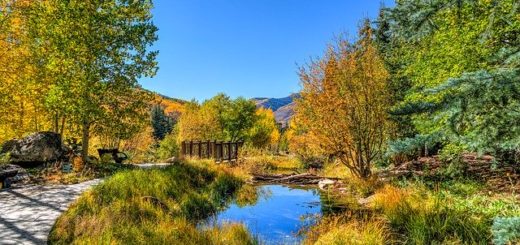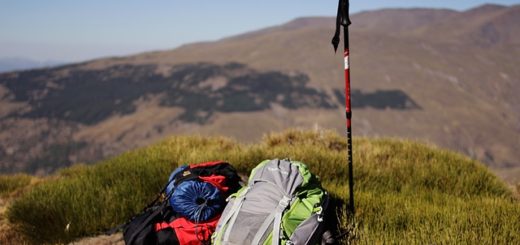Best Backpacking Loops in the US
by Chloe B ·
This page may contain affiliate links. For more information, see our "About Us" page.
Best Backpacking Loops in the US

Backpacking in loops (versus through-hikes which require a sort of shuttle or out-and-backs where you see the same scenery twice over) provides the opportunity to see completely new views every step of the way while keeping the planning and logistics to a minimum. This strategy leaves you more time and mental energy to really take in the backcountry views. You can save even more time by reading this article to learn about some of the best backpacking loops in the US.
Cars are fast and shiny, but let’s face it, there are some places that they just cannot go. Have you ever had that tickle, that electrical urge, to see that forest that is rushing past your window when you drive down the highway? To smell it and touch it in a way that motor vehicles simply cannot allow you to do?
If this description sounds like you, then you’ve got the most important ingredient to backpacking in the bag: curiosity. The next step is to decide where you want to go. Whether you’re on the east coast, the west coast, in the middle, or almost in Canada, the best backpacking loops in the world are right here, in our country’s beautiful wilderness.
#1 - The Grand Canyon
Does this hike even need a preface? Every American has heard of the Grand Canyon and seen pictures of its dusky red majesty. Astonishingly, according the Grand Canyon rangers themselves, only 1% of the population that visits the park hikes into the Canyon. Considering the staggering number of visitors—in the millions!—that pass through the park every year, the 1% that delve into a true exploration of this national monument are truly cream-of-the-crop adventurers.
One of the most popular routes is the Kaibob to Bright Angel loop. In order to backpack this route, you must have a permit to camp at Bright Angel Campground. Once you have the permit, however, you have some options of how to tackle this park. One of the most popular routes is down the south Kaibob trail (8.5 miles of steep, waterless downhill) to Bright Angel Campground (near Phantom Ranch, so it has toilets and water) and then up Bright Angel Trail to the rim (9.8 miles, featuring water halfway at the Indian Garden campground).
Even if you think you know canyons, the Grand Canyon lives up to its name by exploding perceptions of the boundaries of sheer size. It is deeper, redder, and more rugged than the imagination even dares to venture… don’t forget about the little guys though! Mountain goats, foxes, mules, and other creatures abound on this epic loop.
#2 - The Pemigewasset Wilderness Loop (New Hampshire)
The name of this loop is a mouthful and is often shortened to the Pemi Loop. The White Mountains are the home of this New England beauty. One of the main thrills of this 32-mile hike are the eight ‘4000 footers’ featured along the way with names such as Mt. Bond at 4690’ and South Twin at 4902’. While significantly wetter compared to the dust of the Grand Canyon, the Pemi Loop can be stingy with its water. Make sure to fill your tanks when the opportunity presents itself!
The fame and beauty of this hike is not unknown. Many of the peaks can be heavily populated. However, there is an advantage to a higher-than average visitation: cool huts along the way. The first is the Guyot Lean-To, followed by the Garfield Shelter/Lean-To, which is downhill of Mt. Garfield. The description ‘lean-to’ is deceiving, because the Garfield Shelter is anything but fragile. Pushing onward, the Greenleaf Hut is placed about a mile off of the route and requires reservations to stay. The Galehead Hut, located at the bottom of the Garfield Ridge Trail also requires reservations, but hikers can stop for water at this cabin.
This hike is one of extremes—it takes you from high to low, from wet to dry, from forest to rock face, from isolation to cozy civilization.

#3 - The Four Pass Loop, Maroon Bells (Aspen, Colorado)
The Grand Canyon took you down, the Pemi Loop took you up and over peaks of four-thousand feet, but in the Maroon Bells of Colorado, the mountains reach all the way to 14,000 feet high. Don’t be intimidated: this hike only takes you right above 12,000 over the course of the 27-mile loop. That’s nothing…right? Even at 12,000 feet, you will still feel small as you look up at Pyramid Peak, which reaches an astounding 14,014 feet.
The route—starting at Buckskin Pass and then going on to Trail Rider Pass and then to Frigid Air Pass and ending with West Maroon Pass—is famous for the unbelievable panorama of wildflowers that can be seen in the late summer. Monet would have used all of his paint just trying to capture one of the colorful vistas available on this loop!
This loop will not only push your preconceived notion of nature’s palette, but also your knees and hips. For every 12,000’ foot pass you go up, you must, as Newton says, come down. The physical demands of this adventure can be appealing; sometimes, it helps to bring all your problems to the mountains because you’ll be too busy with breathing and muscles burning to worry. But it’s a purifying burn.
#4 - The Grand Gulch Loop (Southeastern Utah)
If you’re reading this article, then you already are gifted in the area of curiosity. But what about archaeology? In the Grand Gulch Primitive Area, you can literally find pieces of pottery and gnawed corn cobs left by the Anasazi tribe of Native Americans. The earliest artifacts date from over 1,800 years ago. Hiking this loop is a privilege and a responsibility: none of the sites are roped off, so you can go into the buildings and touch everything. However, it is an understood rule that hikers do not take anything from the sites, nor vandalize them in any way. It is due to this rule that the sites are still open for exploration.
This hike is a good spring or fall adventure, as the canyon can get viciously hot in summer. Water is available, but scarce, so plan accordingly. A variety of trails lead in and out of the canyon, so you can plan your own loop, according to which sites you wish to visit. The route that goes through Bullet Canyon and Kane Gulch covers many of the quintessential sites. You will have to run shuttle, but this hike is so cool that we couldn’t resist putting it in our compilation of the best backpacking loops in America.

#5 - Timberline Trail, Mount Hood Wilderness (Oregon)
Few people or things get to say that the world revolves around them, but Mt. Hood of Oregon can truthfully say that it is the center of the Timberline Trail universe. This free hike (you only need to get a permit at the trailhead) has many things in common with other alpine backpacking routes like wildflowers and waterfalls, but one characteristic that stands out are the glaciers on Mt. Hood. The biggest glaciers, Eliot and Coe, are on the north side of the mountain, and their water is responsible for keeping the Hood River Valley irrigated.
Early in the season, the glacier run-off does more than just irrigate the Hood River Valley, it also feeds into the streams and rivers that you may encounter on the hike. Be careful on these crossings if you are hiking in the early season—it’s hard to get your balance with a forty-pound backpack once you have lost it. More than one accomplished backpacker has found themselves facedown on a slippery rock with their arms and legs wiggling uselessly like a trout on a line. Here’s the silver lining: you probably won’t get too thirsty with all this water available.
Ice and rock have a sort of bare beauty that the lushness of a forest can lack. This trail is called Timberline because it skirts timberline (about 12,000 feet) for much of the forty miles. Shades of grey can be just as beautiful as the rainbow, if you know how to look for it.
#6 - Grand Island Loop, Grand Island National Recreation Area (Michigan)
Now that you’ve hiked in the east and in the west, it is time to follow the compass north. Way north. Pretty much as north as you can get without needing your passport. The Grand Island Loop is a trail around the Grand Island in the upper peninsula of Michigan. This hike stands out for a variety of reasons—the first settlers that ventured to the island founded a trading post to trade with the Ojibwe tribe of Native Americans! In addition, contrary to the up-and-down of the other hikes in this article, the Grand Island Loop stays pretty level over the course of its 21-mile trail. It is rated as easy/moderate.
Perhaps most thrilling of all are the unique characteristics of the island itself. It is in the biggest freshwater lake in the world. To get to Williams Landing, where the loop starts, you must take the Grand Island Ferry. At night—are those waves you hear?—the lake’s tide will break on the cliffs, lulling you to sleep. The fact that beaches abound doesn’t hurt the reputation of this hike, either.
Best Backpacking Loops in the US - Conclusion
You’ve got the curiosity and now you have the details. Either do all of these backpacking loops or pick the one that is nearest to you and get outside. These hikes are good for toning your thighs, erasing your worries, and rejuvenating your soul. While there are many more, we consider these to be some of the best backpacking loops in the US. If you’re looking for more outdoors information, consider reading our articles “What Should Be In A Backpacking First Aid Kit” as well as “Backpacking Water – How Much to Bring?“. Happy traveling!



